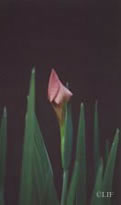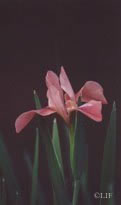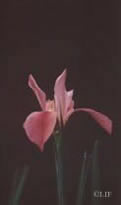Growing Irises in Southern California
by Richard Sloan
|
|
|
 |
 |
 |
|
The Los Angeles, California area is in hardiness zone 10, and winter temperatures do not normally fall below 30°F (-1°C). Maximum summer temperatures may reach 105°F (41°C). Annual rainfall is about 12 inches (30 cm.), most of which occurs during November thru April. Soils are typically neutral to alkaline sandy loams or adobe clay. The growing season for Louisiana irises approaches 12 months if they are watered adequately. There is probably cessation of growth during the summer, but if watered, the plants stay green. Higher elevations in this area have colder winter temperatures and the irises will bloom later. Sun is needed for good bloom, but afternoon shade is helpful, particularly in summer. Avoid areas of tree and shrub roots. Louisiana irises grow well in a regular flower bed or in a lowered bed for easier watering. These are moisture-loving irises and most varieties also grow in water such as a shallow pond or creek, particularly around the edges. If the beds are in full sun, or even partial sun, mulch is essential to avoid sun scald in summer. An acid soil is essential, so in alkaline areas 2-3 pounds (5-7 kg.) of soil sulfur per 100 square feet (9 square meters) should be dug in. New beds should be prepared several weeks before planting and will generally need added humus such as rotted manure, compost or peat moss. It is important to maintain a well balanced soil structure to aid in moisture retention. Clay soils need humus but require less watering than sandy or loose soils. A balanced commercial fertilizer such as 12-12-12 is added when preparing a new bed. While it is possible to plant year-round, fall planting is best, particularly in October or November. Roots must be kept wet after plants are dug and should never be allowed to dry. If the plants cannot be set in their permanent locations, they should be planted in pots or buckets of mud and watered regularly until they can be planted permanently. Rhizomes are planted at or slightly below soil level at least a foot (30 cm.) apart. Even then the plants become crowded in one year. The better the culture the better the plants will multiply. With good culture transplanting and thinning may be required every year or every other year unless rhizomes are planted further apart. Mulching is essential to avoid sun scald in summer. Satisfactory mulches include pine needles, straw, ground leaves, grass clippings or all mixed together and partially composted. About 1-2 inches (2-6 cm.) of mulch is suggested. The mulch can be left on all year and helps keep down weeds and retain moisture. Fertilizer is added to compensate for breakdown of mulch. When beds are reworked the old mulch is dug in for humus and acidity. Several fertilizer applications per year are necessary. Established lumps are given a side-dressing of fertilizer in the fall and again before bloom. Acid type fertilizers sold for azaleas, or any garden variety such as 10-20-10 may be used. High nitrogen fertilizers should be avoided. Liquid fertilizers are faster acting. Slow release types are good in sandy soils. Super phosphate in February or early March gives stronger stalks and better blooms. Water is probably the most important single item in culture of Louisiana irises. They do best with more than average water, but must have it when transplanted, during the growing season and in spring before bloom. They may survive on less water by going dormant during the summer but will put out less increase and less bloom. Regular soakings thru summer will keep the irises growing. Rhizomes will be large and healthy and show good fall increase and excellent bloom in the spring. Watering during all dry periods is desirable, but during the growing season it is essential. With good culture and mild winters, some winter or very early spring bloom may occur on established plants. Otherwise the peak bloom period is with the tall bearded, normally in late April depending on spring temperatures. During the bloom season snails and slugs are a common problem. If they are not eliminated a lowering of show and garden quality blooms will result. Most flowers will produce seed from bee crosses, but not all will have seeds that mature and germinate. Controlled crosses are preferred to bee crosses. Tetraploids have large pods but few seeds. If seed is not desired the stalks are removed after flowering. Pods are harvested when they begin to turn yellow or feel soft. Seeds are best planted at once in flats or pots. Keep planted seeds moist to help break dormancy. Seedlings are transplanted to the garden in early spring. If kept fertilized and watered, a well grown seedling will bloom the next spring. The old stalks are cut off unless seeds are to be kept and planted. For better appearance, dead leaves are carefully removed. Yellow green leaves indicate need for addition of sulfur and iron. Rhizomes must be mulched or covered lightly with soil in summer. If necessary, beds are carefully weeded by hand, but rhizomes should not be disturbed. Treatment for cutworms may be needed. |
